Across America, elementary school students begin their day reciting the pledge of allegiance, declaring “with liberty and justice for all.” However, many Americans do not receive the proclaimed “liberty and justice for all.” Statistics show that America has high rates of incarceration. In the last 40 years, incarceration rates in America have risen by 500% (Williams et al. 2019). In 2006, 1.6 million people were incarcerated in either a state or federal institution (Phelps 2011). By 2015, one adult for every one hundred was incarcerated (Bryan et al. 2015). While these statistics may appear to be bringing justice to those affected by crime, there are clear inequalities within the justice system.

U.S. incarcerates a larger share of its population than any other country. Pew Research. World Prison Brief, Institue for Crime & Justice Policy Research.
Marginalized groups are more likely to become involved with the criminal justice system (Wakefield 2022). Incarceration leads to further inequalities as people continue to be separated from resources and become stigmatized as “criminals” (Wakefield 2022). However, it is possible to provide incarcerated individuals with resources and opportunities during incarceration. Institutions may be able to offer incarcerated individuals with education, vocational job training, mental health treatments, and many other resources that could assist their reentry into society (Forseberg and Douglas 2022).

Racial and Ethnic Disparities. Prison Policy Initiative. U.S. Census Bureau.
The American prison system is impacted by politics, as politicians set the standards and budgets of correctional institutions (Robinson and Soto 2019; Bryan et al. 2015). Therefore, it is important to examine what effects politics has on the prison system. In this study, the independent variable was the governor’s political affiliation, which was categorized as Republican and Democrat. The dependent variable was the appearance of rehabilitative practices.
This research aims to answer the question: What is the effect of a governor’s political affiliation on rehabilitative political affiliation?
This study viewed rehabilitation as the process of reducing inequalities and labels that may lead an individual to commit a crime. Rehabilitative programs were determined based on whether or not they appeared to reduce inequality; provide individuals with reentry support, or allow for an individual to work towards self-improvement. The unit of analysis in this study was correctional facilities’ about pages found within the state’s Department of Corrections webpage. This page included information about the facility and a brief overview of what program the facility offers incarcerated individuals.
Content analysis was used to analyze the information found on the correctional facilities’ about pages. On these websites, there was a specific focus on how information about programs offered were presented. The sampling frame used in this study was correctional facilities in the United States. The sample of facilities was collected using a probability sampling method. After breaking the country down into four regions, one state with a Republican governor and one state with a Democrat governor was selected from each region.
The findings of this study suggested that there is a difference in the rehabilitative practices of facilities in Republican and Democrat-led states. There was a difference in how facilities created empathy towards incarcerated individuals, shown through language and imagery. There was a distinct difference in rehabilitative practices as evidenced by the programming highlighted on the web pages. Religion was also presented differently across the facilties in Republican and Democrat-led states.